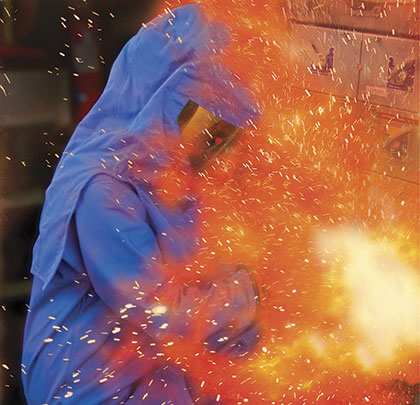OSHA requires that employers “instruct each employee in the recognition and avoidance of unsafe conditions” and the regulations applicable to the workplace “to control or eliminate any hazards or other exposure to illness or injury.” This broad directive underscores the necessity of conducting a hazard assessment—determining the hazards present in the work environment. Indeed, one of the “root causes” of workplace incidents is the failure to identify or recognize hazards that are present, or that could have been anticipated.
Take, for example, electrical hazards. Many workers are unaware of the potential electrical hazards present in their work environment, which makes them more vulnerable to the danger of electrocution. Such hazards include contact with power lines, lack of ground-fault protection, improper use of extension and flexible cords, and equipment not being used in the manner prescribed.
DANGER: ARC FLASHES
Arc flashes are one of the most dangerous electrical hazards. In less than a fraction of a second, an electric arc can hit temperatures of up to 35,000 degrees Fahrenheit—four times hotter than the surface of the sun. The extreme temperature and force caused by an arc flash can spray vaporized metal and shrapnel throughout the area at high speed. Severe injury and burns are likely, and death is possible. Preventing this type of hazard requires a careful assessment of the working environment, job planning, and coordination of work. Equally important is the selection and use of adequate personal protective equipment (PPE).
WEAR PROPER PPE
Article 130 of the National Fire Protection Act (NFPA) 70E requires that all workers within the arc flash boundary wear arc flash rated PPE. PPE must cover all clothing that can be ignited, and must not restrict visibility or movement. Four categories of arc-rated equipment and clothing exist—the categories are rated according to the ability to protect against a minimum energy exposure (measured in cal/cm2). PPE must be labeled with its minimum rating to ensure that it is proper for the particular circumstances and work. Additional equipment includes a hard hat, hearing protection, eye protection, heavy-duty leather gloves, and leather footwear. Arc rated clothing generally consists of an arc-rated shirt and pants, with the addition of high-rated coveralls and/or an arc flash suit at the highest category.
Although four categories of arc-rated PPE are available, a common practice is to provide clothing rated at category 2, with a minimum rating of 8 cal/cm2 and category 4 with a minimum rating of 40 cal/cm2. This allows for the simplification of equipment at a jobsite while also providing adequate protection in all four categories.
MAINTAIN CARE OF PPE
The care and maintenance of arc flash PPE are just as important as its selection. Arc flash PPE should be inspected before each use and should be discarded if visibly damaged or contaminated with a potentially flammable substance such as grease. The PPE must also be cleaned and stored pursuant to the manufacturer’s instructions. Employees should be trained not only in how to use the PPE, but also in how to recognize when it must be repaired or replaced.
While PPE is not a substitute for the strict implementation of safe work practices in preventing arc flashes, it can provide a substantial measure of protection in the event one does occur. Therefore, when performing a hazard assessment on arc flash exposure, employers and supervisors must ensure that adequately rated PPE is available. If, despite all precautions, an arc flash does occur, the correct PPE can mean the difference between a close call and a tragedy.
CONCLUSION
As the above shows, the first step in ensuring OSHA compliance—and, more generally, a safe workplace—is to conduct a hazard assessment. Only once the hazards are identified can the hierarchy of hazard controls be considered and implemented, including appropriate PPE.


About the Authors:
Michael Rubin is a partner in the law firm Goldberg Segalla, where he serves as chair of the OSHA and Worksite Safety Practice Group. He can be reached at 716.844.3477 or mrubin@goldbergsegalla.com. Stefan Borovina is an attorney in Goldberg Segalla’s OSHA and Worksite Safety Practice Group. He is a certified Construction Health and Safety Technician and has completed the OSHA 30 Construction and General Industry Training. He can be reached at 516.281.9828 or sborovina@goldbergsegalla.com.
_________________________________________________________________________
Modern Contractor Solutions, January 2018
Did you enjoy this article?
Subscribe to the FREE Digital Edition of Modern Contractor Solutions magazine.



